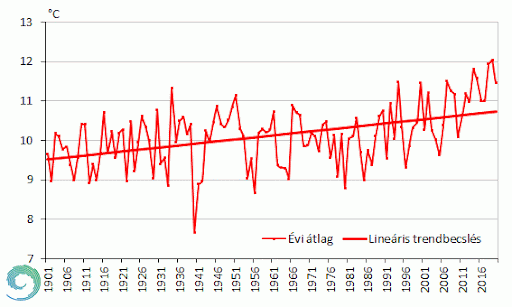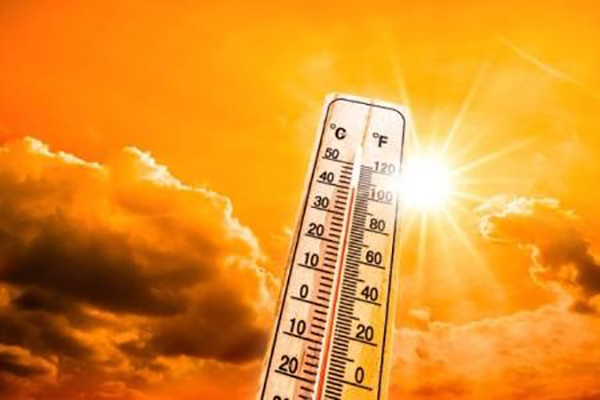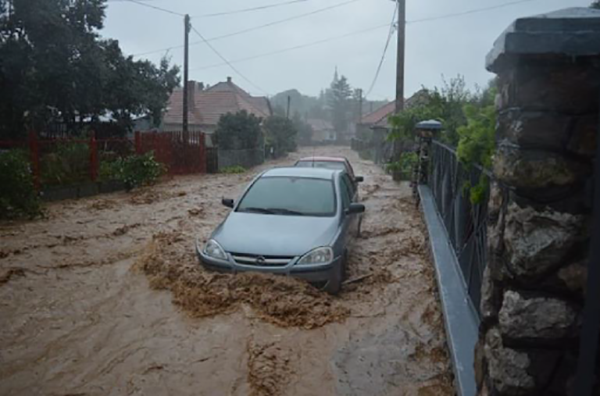Hungary’s climate nowadays. What kind of extreme weather events are expected in Hungary as a result of climate change, and how will they affect our lives?
- December 11, 2021
- 7:27 pm
The Earth’s climate is changing permanently and significantly. The average temperature of the planet is rising, which also affects precipitation and other characteristics of the climate. However, this is not just about warming, but extremes in our weather are expected to be more common on Earth and in Hungary.
In the last more than a century Hungary’s climate has warmed measurably, and the average temperature has been rising strongly since the 1980s. These tendencies are already visible in domestic observations. Between 1901 and 2020, the annual mean temperature increased by 1.23°C. Springs and summers have been warmed the most, by 1.44 °C and 1.33 °C, respectively.
2018 was the hottest year since the beginning of the measurements, and 8 of the 10 warmest years occurred in Hungary after the turn of the millennium. So the signs of climate change can already be detected nowadays, but its effects will intensify in the future. The temperature is expected to rise further in Hungary: based on pessimistic scenarios, the average temperature could rise even by 3.5-4.5 °C by the end of the century.

Figure 1. National annual average temperatures between 1901 and 2020 (based on homogenized, interpolated data) Source of the figure: The Hungarian Meteorological Service (OMSZ)
2018 was the hottest year since the beginning of the measurements, and 8 of the 10 warmest years occurred in Hungary after the turn of the millennium. So the signs of climate change can already be detected nowadays, but its effects will intensify in the future. The temperature is expected to rise further in Hungary: based on pessimistic scenarios, the average temperature could rise even by 3.5-4.5 °C by the end of the century.
Precipitation is highly variable in space and time, so it is harder to detect trends –due to climate change – than in the case of temperature. However, the distribution of precipitation within a year has changed, with less rain falling in summer and slightly more in autumn and winter. In addition, it is observed that there are fewer days with precipitation and the tendency to drought has increased. The number of heavy rainfall events has also increased, as the rainfall reaches the surface in the form of short-term, intense showers accompanied by lightning, heavy hail and windstorms. The wettest year registered by the OMSZ since the beginning of the measurements was the year 2010, which was also associated with huge flood waves.
There is already a significant increase in the frequency and intensity of extreme weather events caused by climate change and the number of these events will continue to rise. What kind of extreme weather events can be observed or are expected, and how do they affect our lives?
- Extreme warm weather events have become more frequent since the 1980s, with an increase in their average length and intensity. Extremely hot periods (heat waves) put a strain on human health (especially on the circulation), while strong UV radiation can lead to more frequent development of skin diseases.
- During the extremely cold periods and frosts, the risk of colds and freezing may increase among the particularly vulnerable social groups, but e.g. sticky snow and frost can cause serious damage both in our forests and aierials.
- Large-scale rainfall events (even hail) in a short period of time can cause inundations or flash floods to endanger building stock, roads, and critical infrastructure, as well as human life.

- Storms with intense gusts of wind can also adversely affect the built environment, homes, property, and human life. In addition, roads may become impassable and critical infrastructure elements may be damaged (e. g. it could cause gas and electricity outages).
- As a result of changes that can already be observed and expected (changes in the annual rainfall distribution, an increase in the average annual temperature, etc.), droughts become more frequent, which can cause damage to agricultural production.
- The deterioration of the condition of forests is already occurring in Hungary. International examples confirm the expected increase in the frequency of forest fires, for which we must be constantly prepared in our country.

Flowing water on a street of Múcsony on 28.07.2016.
We are facing changes, much of which are inevitable, but we can take steps in order to minimise the damage they could do in our life and in our environment, so we have the opportunity to mitigate impacts, prepare consciously and adapt thoughtfully. These will be discussed in our further articles.
Sources:
[1] 2018 is the warmest year in Hungary since 1901 – preliminary climate assessment. OMSZ: January 4, 2019 https://www.met.hu/omsz/OMSZ_hirek/index.php?id=2384
[2] Data and information of the National Meteorological Service –https://www.met.hu/eghajlat/magyarorszag_eghajlata/eghajlati_visszatekinto/elmult_evek_idojarasa/, https://www.met.hu/eghajlat/eghajlatvaltozas/megfigyelt_valtozasok/Magyarorszag/
[3] Further development of the National Adaptation Geo-information System (NAGiS) project – public information, awareness raising publications
[4] Report on the Scientific Assessment of the Potential Impacts of Climate Change on the Carpathian Basin, MIT, Government Report, 8 January 2010
[5] Parliament 23/2018. (X. 31.) parliamentary decree on the Second National Climate Change Strategy for the period 2018–2030, providing an outlook for the period up to 2050
Image source: istockphoto.com, pixabay.com, http://www.boon.hu/video-ozonvizszeru-felhoszakadas-es-sarlavina-pusztitott-mucsonyban/3125914, ÉMIVZIG: Development of the weather and water situation in 2016
